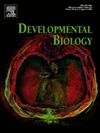秀丽隐杆线虫的锚定细胞分化、外阴诱导和形态发生部分需要中央纺锤蛋白。
IF 2.5
3区 生物学
Q2 DEVELOPMENTAL BIOLOGY
引用次数: 0
摘要
秀丽隐杆线虫的外阴发育是一种相对简单的器官发育模式,即来自上覆性腺的信号诱导3个上皮细胞进行3轮细胞分裂,产生22个组成外阴的细胞。外阴细胞命运的确定需要体细胞性腺和下层上皮中通过LIN-12/Notch和LET-23/EGFR通路的细胞分裂和细胞信号传导之间的协调。在这里,我们描述了中央纺锤复合体在外阴发育中的作用。Centralspindlin是ZEN-4/KIF23和CYK-4/RacGAP1的异源四聚体,在早期胚胎细胞分裂过程中完成细胞分裂是必不可少的。我们发现,在发育中的体细胞性腺中,中央纺锤蛋白是完成细胞分裂所必需的,因此,LIN-3/ egf分泌锚细胞(AC)的指定对LET-23/ egfr介导的外阴诱导至关重要。然而,在胚胎后发育过程中,中央纺锤体对细胞分裂的要求是不完整的,因为AC经常被指定,尽管通常是双核的。双核AC的存在与外阴诱导相关,表明LET-23/EGFR信号在很大程度上是功能性的。在外阴细胞的细胞分裂过程中,中央纺锤蛋白也是部分必需的,它是外阴形态发生而不是诱导所必需的。我们还发现,CYK-4/RacGAP1的GAP结构域在胚胎分裂过程中需要收缩环组装,但对于体细胞性腺和外阴的发育并不必需。因此,在体细胞性腺和外阴的胚胎后发育过程中,与早期胚胎发生相比,对中央纺锤蛋白的需求似乎有所不同。本文章由计算机程序翻译,如有差异,请以英文原文为准。
Centralspindlin is partially required for C. elegans anchor cell specification, vulval induction and morphogenesis
Caenorhabditis elegans vulval development is a relatively simple model of organ development whereby a signal from the overlying gonad induces three epithelial cells to undergo three rounds of cell division to generate 22 cells that make up the vulva. Specification of the vulval cell fates requires coordination between cell division and cell signaling via LIN-12/Notch and LET-23/EGFR pathways in the somatic gonad and the underlying epithelium. Here we characterize the role of the centralspindlin complex in vulval development. Centralspindlin, a heterotetramer of ZEN-4/KIF23 and CYK-4/RacGAP1, is essential for completion of cytokinesis during early embryonic cell divisions. We found that centralspindlin is required for completion of cytokinesis in the developing somatic gonad and hence specification of the LIN-3/EGF-secreting anchor cell (AC) critical for LET-23/EGFR-mediated vulval induction. However, the requirements for centralspindlin for cytokinesis during postembryonic development are incomplete as the AC is frequently specified, though often binucleate. The presence of the binucleate AC correlates with vulval induction demonstrating that LET-23/EGFR signaling is largely functional. Centralspindlin is also partially required for cytokinesis of the vulval cells where it is required for vulval morphogenesis rather than induction. We also found that the GAP domain of CYK-4/RacGAP1 required for contractile ring assembly during embryonic division is not essential for development of the somatic gonad and the vulva. Thus, there appears to be different requirements for centralspindlin during postembryonic development of the somatic gonad and vulva as compared to early embryogenesis.
求助全文
通过发布文献求助,成功后即可免费获取论文全文。
去求助
来源期刊

Developmental biology
生物-发育生物学
CiteScore
5.30
自引率
3.70%
发文量
182
审稿时长
1.5 months
期刊介绍:
Developmental Biology (DB) publishes original research on mechanisms of development, differentiation, and growth in animals and plants at the molecular, cellular, genetic and evolutionary levels. Areas of particular emphasis include transcriptional control mechanisms, embryonic patterning, cell-cell interactions, growth factors and signal transduction, and regulatory hierarchies in developing plants and animals.
 求助内容:
求助内容: 应助结果提醒方式:
应助结果提醒方式:


